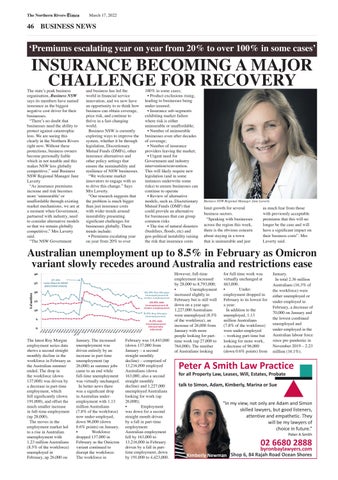The Northern Rivers Times
March 17, 2022
46 BUSINESS NEWS
‘Premiums escalating year on year from 20% to over 100% in some cases’
INSURANCE BECOMING A MAJOR CHALLENGE FOR RECOVERY
The state’s peak business organisation, Business NSW says its members have named insurance as the biggest negative cost driver for their businesses. “There’s no doubt that businesses need the ability to protect against catastrophic loss. We are seeing this clearly in the Northern Rivers right now. Without these protections, business owners become personally liable which in not tenable and this makes NSW less globally competitive,” said Business NSW Regional Manager Jane Laverty “As insurance premiums increase and risk becomes more ‘uninsurable’ or unaffordable through existing market mechanisms, we are at a moment when Government, partnered with industry, need to consider alternative models so that we remain globally competitive,” Mrs Laverty said. “The NSW Government
and business has led the
innovation, and we now have an opportunity to re-think how business can obtain coverage, price risk, and continue to thrive in a fast-changing world. Business NSW is currently exploring ways to improve the system, whether it be through legislation, Discretionary Mutual Funds (DMFs), other insurance alternatives and other policy settings that ensure the sustainability and resilience of NSW businesses. “We welcome market innovators to engage with us to drive this change.” Says Mrs Laverty. “Our research suggests that the problem is much bigger than just insurance costs with wider trends around insurability presenting businesses globally. These trends include: • Premiums escalating year on year from 20% to over
100% in some cases; • Product exclusions rising, leading to businesses being under-insured; • Insurance sub-segments exhibiting market failure where risk is either uninsurable or unaffordable; • Number of uninsurable businesses even after decades of coverage; • Number of insurance providers leaving the market; • Urgent need for Government and industry intervention/reinvention. This will likely require new legislation (and in some instances underwrite some risks) to ensure businesses can continue to operate • Review of alternative models, such as, Discretionary Mutual Funds (DMF) that could provide an alternative for businesses that can group common risks • The rise of natural disasters
geo-political instability raising the risk that insurance costs
Business NSW Regional Manager Jane Laverty
limit growth for several business sectors. “Speaking with businesses across the region this week, there is the obvious concern about staying in a town that is uninsurable and just
as much fear from those with previously acceptable premiums that this will no longer be the case and will their business costs”. Mrs Laverty said.
Australian unemployment up to 8.5% in February as Omicron variant slowly recedes around Australia and restrictions ease
The latest Roy Morgan employment series data shows a second straight monthly decline in the workforce in February as the Australian summer ended. The drop in the workforce (down 137,000) was driven by a decrease in part-time employment, which 191,000), and offset the much smaller increase in full-time employment (up 28,000). The moves in the employment market led to a rise in Australian unemployment with 1.23 million Australians (8.5% of the workforce) unemployed in February, up 26,000 on
January. The increased unemployment was driven entirely by an increase in part-time unemployment (up 26,000) as summer jobs came to an end while full-time unemployment was virtually unchanged. In better news there in Australian underemployment with 1.13 million Australians (7.8% of the workforce) now under-employed, down 96,000 (down 0.6% points) on January. • Workforce dropped 137,000 in February as the Omicron variant continued to disrupt the workforce: The workforce in
February was 14,443,000 (down 137,000 from January – a second straight monthly decline) – comprised of 13,216,000 employed Australians (down 163,000, also a second straight monthly decline) and 1,227,000 unemployed Australians looking for work (up 26,000); • Employment was down for a second straight month driven by a fall in part-time employment: Australian employment fell by 163,000 to 13,216,000 in February driven by a fall in parttime employment, down by 191,000 to 4,423,000.
However, full-time employment increased by 28,000 to 8,793,000; • Unemployment increased slightly in February but is still well down on a year ago: 1,227,000 Australians were unemployed (8.5% of the workforce), an increase of 26,000 from January with more people looking for parttime work (up 27,000 to 764,000). The number of Australians looking
for full-time work was virtually unchanged at 463,000. • Underemployment dropped in February to its lowest for a year: In addition to the unemployed, 1.13 million Australians (7.8% of the workforce) were under-employed – working part-time but looking for more work, a decrease of 96,000 (down 0.6% points) from
January. In total 2.36 million Australians (16.3% of the workforce) were either unemployed or under-employed in February, a decrease of 70,000 on January and the lowest combined unemployed and under-employed in the Australian labour force since pre-pandemic in November 2019 – 2.23 million (16.1%).







